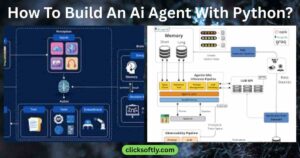How To Build An Ai Agent With Python – Learn the step-by-step process to create your first AI agent using Python in this beginner-friendly 2025 guide. Discover essential tools, libraries, and tips for building smart, functional agents from scratch.
Building an AI agent with Python involves creating algorithms that can learn. Start by defining the agent’s purpose and tasks it will perform.
Python is widely used for AI development due to its simplicity and extensive libraries. Artificial intelligence is transforming industries by automating tasks and making predictions. Python is a popular choice for developing AI agents because it offers powerful libraries like TensorFlow and PyTorch.
These libraries help in creating complex neural networks. Building an AI agent involves understanding machine learning concepts and coding them efficiently. Python’s readability makes it accessible to both beginners and experienced developers.
With Python, you can create agents that learn and adapt. Discover the steps to build your own AI agent and explore the possibilities of Python in AI development. Ready to embark on your AI journey? Let’s dive in!

Introduction To Ai Agents
Building AI agents with Python can be an exciting journey. Whether you’re an experienced coder or just starting, understanding AI agents is crucial. They are the backbone of intelligent systems, acting autonomously and making decisions.
As you dive into this world, you’ll find these agents everywhere—from the apps on your phone to complex systems in industries. But what exactly are AI agents? Let’s break it down.
Defining Ai Agents
AI agents are computer programs designed to perform tasks autonomously. Unlike regular software, they can make decisions without constant human guidance. Imagine a virtual assistant that schedules your meetings. It analyzes your calendar, suggests suitable times, and sends out invites—all on its own. This capability is what sets AI agents apart.
AI agents can learn and adapt. They use algorithms to process data and improve over time. Think of them as learners. As they gather information, they refine their actions to be more effective. This adaptability makes them invaluable in dynamic environments.
Real-world Applications
AI agents have found their place in numerous industries. In healthcare, they assist in diagnosing diseases by analyzing medical data. In finance, they predict market trends and manage investments. Have you ever wondered how customer service chats respond so quickly? AI agents are behind the scenes, answering queries and resolving issues.
Consider transportation. AI agents power autonomous vehicles, making real-time decisions to navigate safely. They are also used in agriculture, optimizing crop management and improving yields. The list goes on, but the central theme is clear: AI agents are transforming how tasks are performed.
As you think about building your AI agent, ask yourself: What problem do you want to solve? How can an AI agent enhance your project? The possibilities are vast, and your creativity will shape the outcome.
How To Build An Ai Agent With Python, Choosing The Right Tools
Selecting the right tools is crucial for building an AI agent with Python. Python libraries like TensorFlow and PyTorch provide robust support for AI development. Understanding your project’s needs helps in choosing the most suitable tools effectively.
Choosing the right tools is crucial when building an AI agent with Python. The tools you select can significantly affect the efficiency and functionality of your project. Making informed decisions here can save you time and frustration down the line.
Let’s dive into why Python stands out and explore essential libraries that make your AI agent development smoother.

Python As A Preferred Language
Python is a top choice for AI development, and it’s not just because it’s easy to learn. Its simplicity allows you to focus more on solving complex AI problems rather than getting bogged down by syntax issues. The vast community support means you can find solutions and resources for almost any AI-related challenge you encounter.
Python’s extensive libraries are another reason for its popularity. It offers a variety of tools specifically designed for AI and machine learning. These libraries make the development process more efficient, enabling you to build robust AI agents quickly.
Have you ever wondered why many tech giants choose Python for their AI projects? Companies like Google and Facebook utilize Python due to its scalability and flexibility, which are crucial for handling large-scale AI systems.
Essential Libraries
To build a powerful AI agent, you need the right libraries. TensorFlow is one of the most popular libraries for machine learning and deep learning. It provides a comprehensive ecosystem to deploy ML models on different platforms. Scikit-learn is another essential library, especially if you’re focusing on data analysis and machine learning.
It’s perfect for tasks like classification, regression, and clustering. Keras is user-friendly and highly efficient for creating neural networks. It runs on top of TensorFlow, making it a great choice for beginners and experts alike. If you’re dealing with natural language processing (NLP), NLTK and spaCy are invaluable. They offer tools to work with human language data effectively.
Curious about how these libraries can enhance your AI agent? Imagine needing to process large datasets quickly. These libraries allow you to execute complex operations in just a few lines of code, saving you both time and effort. In your AI journey, the right combination of Python and its libraries can be a game-changer. So, what tools will you choose to bring your AI project to life?
How To Build An Ai Agent With Python, Setting Up Your Environment
Creating an AI agent with Python starts with setting up your environment properly. Install Python, download necessary libraries, and configure your system. This ensures a smooth development process for your AI project.
Setting up your environment is crucial for building an AI agent with Python. A well-prepared environment ensures smooth development and execution of your code. This process involves installing Python and setting up an Integrated Development Environment (IDE). Each step is essential to create a seamless workflow. With the right setup, you’ll write, test, and debug your AI applications efficiently.
Installing Python
First, download and install the latest version of Python. Visit the official Python website. Choose the appropriate version for your operating system. For Windows, select the installer and run it. Ensure you check the box to add Python to your PATH. This step allows you to run Python from the command line. For macOS or Linux, follow the installation instructions provided.
This typically involves using a package manager. Once installed, verify the installation by opening a terminal. Type `python –version` to check the version number. This confirms Python is ready for use.

How To Build An Ai Agent With Python, Setting Up Ide
Next, set up a robust IDE for coding. An IDE helps you write and manage code efficiently. Popular options include PyCharm, Visual Studio Code, and Jupyter Notebook. Download and install your chosen IDE from its official website. For PyCharm, select the Community Edition for a free option. Visual Studio Code is also free and supports many extensions.
Jupyter Notebook is ideal for projects involving data analysis. Open your IDE and configure it to suit your preferences. Adjust themes, fonts, and layouts for comfort. Install Python-related extensions or plugins for enhanced features. This setup will streamline your coding experience.
Data Collection And Preparation
Building an AI agent with Python starts with data collection and preparation. This step is critical. It shapes your AI’s learning and performance. Quality data leads to better AI results. Let’s explore how to collect and prepare data effectively.
Finding Relevant Data
Relevant data is key to training your AI agent. Start by identifying the data sources. Use online datasets, APIs, or web scraping tools. Ensure the data aligns with your AI’s objectives. Check for data availability and accessibility. It should be easily downloadable and in a usable format.
How To Build An Ai Agent With Python, Cleaning And Preprocessing
Raw data often contains errors and inconsistencies. Cleaning data involves removing duplicates and correcting errors. Handle missing values appropriately. Choose to fill them or discard them based on context.
Preprocessing prepares data for AI algorithms. Convert data into a consistent format. Normalize numerical values and encode categorical data. This helps the AI model understand the data better.
Designing The Agent’s Architecture
Creating an AI agent involves careful planning. The architecture is crucial. A well-designed structure ensures efficiency and functionality. This section explores two key components. Selecting an AI model and understanding neural networks. These elements form the backbone of the agent.
Selecting An Ai Model
Choose the right AI model for your task. Models vary in complexity and capability. Consider your project’s needs. Simpler models are easier to implement. Complex models offer more flexibility. Popular models include decision trees and support vector machines. Each has unique strengths.
How To Build An Ai Agent With Python, Understanding Neural Networks
Neural networks mimic the human brain. They process information through layers. Each layer refines data for better output. Understanding their structure is vital. Input, hidden, and output layers work in harmony. Adjust layers to improve performance. Training involves feeding data and learning patterns. Neural networks excel in handling complex tasks.

Coding The Ai Agent
Building an AI agent with Python might sound daunting, but it’s a journey filled with discovery. Imagine creating a digital brain that learns and evolves. This is where coding comes into play. You’ll be crafting algorithms and implementing machine learning models to bring your AI agent to life. Each line of code is a step towards creating something truly innovative. Ready to dive into the world of coding?
How To Build An Ai Agent With Python, Writing The Core Algorithm
Your AI agent’s core algorithm is like the brain’s logical processor. It’s where decisions are made. Start by defining the problem your agent will solve. Is it predicting weather patterns or playing chess? Once you have clarity, begin writing the algorithm. Use simple logic structures like loops and conditionals.
Think about how your AI will handle various inputs. Consider edge cases to ensure your algorithm is robust. Test your code frequently. Debugging is part of the process, so don’t shy away from errors—they’re stepping stones. Remember, even the most seasoned developers face challenges.
Have you ever written code that seemed perfect but failed on the first run? That’s part of the learning curve. Each failure is a lesson that pushes you closer to success. Keep refining until your algorithm performs seamlessly.
Implementing Machine Learning Models
Machine learning models are the magic behind AI’s ability to learn and adapt. Begin by choosing a model that suits your problem—linear regression, decision trees, or neural networks are popular choices. Libraries like scikit-learn and TensorFlow make implementation easier.
Load your data and prepare it meticulously. Clean data is crucial for accurate predictions. Train your model using a portion of your dataset and validate it with the rest. Aim for a model that learns efficiently and makes reliable predictions.
Ever wondered why some models outperform others? It’s often about data quality and model tuning. Spend time tweaking parameters. Try different models to see which performs best. Your AI agent’s success depends on this experimentation.
As you code, ask yourself: What makes my AI agent unique? How can it add value? Your answers will guide you towards creating an impactful digital companion. Embrace the coding challenge, and your AI agent will soon be ready to conquer real-world problems.
How To Build An Ai Agent With Python, Training And Testing
Creating an AI agent with Python involves training and testing models. Python libraries like TensorFlow simplify this process. Start by selecting data, then use algorithms to train your model for accuracy. Testing ensures the agent performs tasks effectively, adapting to new data inputs.
Training and testing are crucial steps in building an AI agent using Python. These stages ensure your AI model learns effectively and performs well in real-world scenarios. Without proper training and testing, your AI agent may produce unreliable results, leaving you scratching your head in frustration.

Training The Model
Training your model involves feeding it data so it can learn patterns. Start by selecting a dataset that represents the problem you’re trying to solve. Use Python libraries like TensorFlow or PyTorch to build and train your model. Focus on adjusting parameters to improve the model’s learning process.
You might tweak the learning rate or modify the number of layers in your neural network. Experimentation is key, so don’t hesitate to try different configurations. Consider if your model is learning efficiently by observing the loss function.
A decreasing loss indicates effective learning, while a stagnant loss might require more data or a change in approach. How can you ensure your model isn’t overfitting or underfitting?
How To Build An Ai Agent With Python, Evaluating Performance
Once training is complete, it’s time to evaluate your model’s performance. Use a separate test dataset to assess how well your model generalizes to new data. This step helps you understand if your model can make accurate predictions in real-world situations. Performance metrics like accuracy, precision, and recall are your best friends here.
They provide insights into the strengths and weaknesses of your model. For example, a high accuracy with low recall might suggest your model is missing some relevant instances. Visual tools, such as confusion matrices, can offer a clear picture of your model’s performance. They help identify specific areas where your model excels or struggles.
What insights can you gain from visualizing your model’s performance? Building an AI agent is an iterative process, with training and testing at its core. These steps not only refine your model but also enhance your understanding of AI development. Are you ready to take your AI agent to the next level?

How To Build An Ai Agent With Python, Deployment And Integration
Creating an AI agent with Python involves deploying and integrating various components efficiently. Python’s libraries simplify the process, enabling seamless data handling and algorithm implementation. Achieving smooth integration ensures your AI agent operates effectively, adapting to new data and environments.
Building an AI agent with Python is a thrilling journey that concludes with deployment and integration. These final steps transform your agent from a mere codebase into a functional tool. It’s time to bring your AI agent out of the development environment and into the real world, where it can interact with users and applications effectively.
Deploying The Agent
Deploying your AI agent is like setting up a new gadget you’ve just bought. You want it to work seamlessly and efficiently from the get-go. Start by choosing the right platform. You might consider cloud services like AWS or Google Cloud for scalability. Next, package your agent. Use Docker to create containers that ensure your agent runs smoothly in any environment.
It’s like boxing up your gadget in a way that protects it during transport. Finally, consider security. Protect your AI agent with encryption and secure APIs. Just as you wouldn’t leave your house unlocked, make sure your agent is safe from digital threats.
Integrating With Applications
Imagine your AI agent as the brain behind your application. Integration is about connecting the brain to the body. Begin by identifying the applications that will benefit most from your agent’s capabilities. Use APIs to bridge the gap between your agent and these applications.
This connection allows your agent to receive and process real-time data. It’s like plugging your smartphone into a charger—your agent needs this link to function optimally. Think about user experience. How will your users interact with your AI agent?
Will it be through a web interface or a mobile app? Design intuitive ways for users to engage with your agent, ensuring a smooth and rewarding experience. As you deploy and integrate, ask yourself: How can my AI agent best serve its purpose? Keep your goals clear and your execution precise.

How To Build An Ai Agent With Python? Challenges And Solutions
Building an AI agent with Python presents unique challenges, such as data handling and algorithm selection. Solutions include using libraries like TensorFlow and PyTorch for efficient processing and learning. Understanding these tools simplifies the development process and enhances performance.
Building an AI agent with Python can be an exciting journey. Yet, it often comes with its own set of challenges. As you delve into this fascinating process, you’ll encounter hurdles that may seem daunting at first. But don’t worry—every challenge has a solution. Let’s dive into some common issues and the ways to overcome them, while also exploring how to optimize performance effectively.
How To Build An Ai Agent With Python, Common Issues
When you start building an AI agent, expect to face bugs and errors. It’s a part of the learning process, not a sign of failure. A common issue is data handling. You might find yourself struggling with the size or complexity of data sets. Imagine spending hours cleaning data only to realize it’s missing vital elements. To tackle this, focus on smaller chunks of data initially.
This allows you to test and refine your methods before scaling up. Another obstacle is algorithm selection. With numerous algorithms available, choosing the right one can be overwhelming. Consider starting with a simple algorithm and gradually experimenting with others to see what fits your project best.
Optimizing Performance
Performance optimization is crucial for AI agents. A slow agent can lead to frustration and inefficiencies. One effective strategy is parallel processing. By running tasks concurrently, you can significantly reduce execution time. Think of a time when you were multitasking—handling several tasks at once can often be more efficient than tackling them one by one.
Similarly, parallel processing enhances an AI agent’s speed. Another approach is optimizing your code. Python offers various libraries like NumPy and TensorFlow that can streamline operations. Using these can save you both time and resources. Have you ever wondered if your agent could learn faster?
Implementing techniques like caching results can speed up repeated tasks, making your agent smarter and quicker. In the end, building an AI agent is not just about overcoming challenges. It’s about discovering solutions that transform obstacles into stepping stones. What challenges have you faced in your coding journey, and how did you turn them into opportunities?
How To Build An Ai Agent With Python, Future Prospects
The future of AI agents built with Python looks bright. Continuous advancements and emerging trends promise exciting possibilities. Developers and businesses have much to anticipate. Let’s explore these future prospects in more detail.

Advancements In Ai
AI technology is rapidly evolving. New algorithms and models are being developed. These innovations improve efficiency and accuracy. Python plays a significant role in this progress. Its libraries, like TensorFlow and PyTorch, enable powerful AI solutions. Open-source contributions also speed up development. As AI advances, Python remains a key tool for developers.
How To Build An Ai Agent With Python, video!
Emerging Trends
Several trends are shaping the AI landscape. One is the rise of ethical AI. Developers are focusing on transparency and fairness. Another trend is AI-powered automation. Businesses seek to automate repetitive tasks. This increases productivity and reduces costs. AI agents are also becoming more user-friendly. This makes them accessible to a wider audience. Developers are creating more interactive and intuitive interfaces.
AI agents are also increasingly integrated into IoT devices. This trend allows for smarter homes and cities. Python’s compatibility with IoT frameworks enhances this integration. The demand for AI skills is also growing. More educational resources and courses are available. This helps developers stay updated with the latest trends.

Frequently Asked Questions
How To Create An Ai Agent In Python?
Install Python and necessary libraries like TensorFlow or PyTorch. Write code to define the agent’s environment. Implement the agent’s decision-making logic using machine learning algorithms. Train the AI agent with relevant data. Test and refine the agent to improve performance and accuracy.
Can I Create My Own Ai Using Python?
Yes, you can create your own AI using Python. Utilize libraries like TensorFlow, PyTorch, and scikit-learn. Python offers tools for machine learning, deep learning, and data analysis. Beginners can start with tutorials and online resources to build AI applications.
How Do I Create My Own Ai Agent?
Begin by choosing a programming language like Python. Use libraries and frameworks such as TensorFlow or PyTorch. Train your agent with relevant data. Implement algorithms for decision-making. Test and refine your AI agent continually. Consider using cloud platforms for scalability and deployment.
Can Python Be Used To Build Artificial Intelligence Algorithms?
Yes, Python is widely used for developing artificial intelligence algorithms. It offers libraries like TensorFlow, Keras, and PyTorch. Python’s simplicity and readability make it ideal for AI projects. Its robust community support aids in solving complex AI problems effectively. Python’s versatility enhances AI development across various applications.
Conclusion
Building an AI agent with Python is achievable and fun. You’ve learned the basics and essential steps. Python provides powerful tools for AI development. Start small and gradually enhance your skills. Practice consistently to gain confidence. Experiment with different projects to deepen your understanding.
Remember, learning takes time and patience. Don’t hesitate to seek help from online communities. They can offer guidance and support. Stay curious and keep exploring new possibilities. Your journey in AI development has just begun. Keep coding and enjoy the process.
Success will follow with dedication and effort.



Leave a Reply